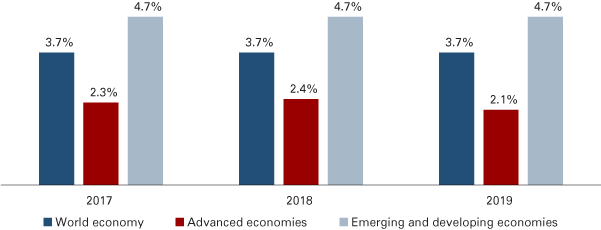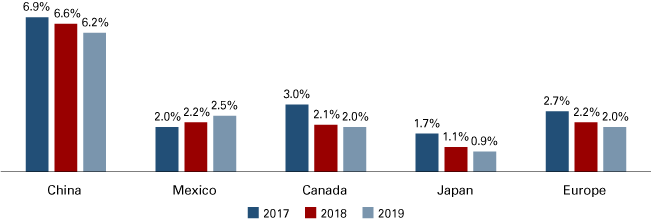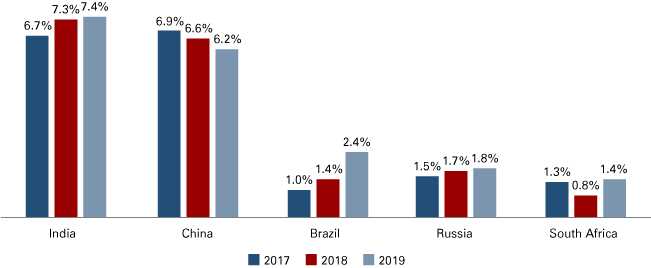International outlook for 2019: Steady growth through the trade storm?

Associate Professor of Finance, Kelley School of Business, Indiana University

Clinical Assistant Professor of Business Economics and Public Policy, Kelley School of Business, Indiana University Bloomington
2018 was marked by a brisk increase in trade tensions elicited by the United States’ protectionist measures against its major trading partners: the European Union, China, Canada and Mexico. These tensions have only been heightened by each country’s round of retaliatory trade restrictions placed on U.S. goods. So far, these trade wars have affected only a small fraction of the world’s volume of imports and exports, which has contained the repercussions from spreading to the global financial market. Therefore, the International Monetary Fund (IMF) projects 2019 world output to continue to grow at a robust pace of 3.7 percent (see Figure 1).
Figure 1: Real GDP growth (%)

Note: 2018 and 2019 values are projections.
Source: International Monetary Fund
However, if trade wars continue to amplify, the balance of the risks for 2019 will be biased to the downside. Adding to these fears are increased geopolitical tensions that may drive up the price of oil. Also, there is increased fear from rising credit costs, which is created by tighter capital markets, as many of the world’s central banks are expected to continue (or start) raising interest rates. All of these uncertainties can disrupt global expansion by affecting market confidence and ultimately decrease business and household spending, which in 2018 has been the principal engine of growth.
Advanced economies
Projected economic indicators (real GDP growth, unemployment rates and inflation rates) remain encouraging in the advanced economies. Nevertheless, a greater divergence in the pace at which advanced economies are growing is noticeable and could signal heightened medium-term risks. For example, the United States is expected to sustain growth above its long-term potential in 2019, while many other advanced economies (for example, Japan and the U.K.) are falling back to their potential.
United States
In the United States, the powerful budget stimulus of the current administration is further incentivizing economic activity that is forecasted to grow at 2.5 percent in 2019. Consumer and business confidence are very high, and this should continue to bring the unemployment rate to levels not seen in decades. The domestic risk is the reignition of inflation and, internationally, the exacerbation of the global imbalances that could increase exchange rate volatility. Also, as the U.S. is expected to grow relatively faster, U.S. imports will increase and so will the U.S. trade deficit. All these will contribute to the increase of U.S. interest rates and create political tensions between the monetary and executive authorities, as well as between the U.S. and their trading partners.
Eurozone
In the eurozone, 2018 expansion was boosted by good economic performance in Germany, the Netherlands and the Iberian Peninsula. The economic activity was further supported by the European Central Bank’s continued accommodating monetary policy and increased government spending. Furthermore, European workers enjoyed higher real wages and lower unemployment rates causing an increase in private consumption. Also, improved business confidence drove investment higher and helped sustain a pace of growth beyond historical trends. Given that the dispute between the U.S. and the eurozone was limited to the steel and aluminum sectors, no significant effects of the trade war were recorded for most of 2018. However, the uncertainties related to rising protectionism are accumulating and will start weighting on business confidence in 2019. The IMF forecasts slower growth in the area as the projection for 2019 is 1.9 percent. Furthermore, increased political turmoil in Italy is also tilting the risks for the area to the downside.
United Kingdom
In the U.K., the 2019 prediction for growth is modest at 1.5 percent. This is due to the expected slowdown of the EU, the main trading partners of the U.K., but also because of the drag from ongoing economic and political uncertainty relating to the Brexit negotiations. The uncertainty is hurting consumer confidence, as well as business investment—and this is despite the decrease in inflation that usually improves private spending. The negotiation between the U.K. and the rest of the EU is set to end in March 2019, and the prospect of a “no deal” looms large. A “no deal” refers to no agreement on the terms of the future commercial and political relationships with the 27 EU members. This “no deal” would come with unpredictable economic and financial risk, especially since the EU members may reinstate tariffs and other restrictions on British exports. The expected repercussions of a “no deal” range from higher border costs to disruption of many industries’ supply chains. It is also possible that when “freed” from European bureaucracy, the U.K. will engage in trade arrangements with fast-growing parts of the world (namely the U.S. and China) and make up for that shortfall. But as for 2019, it is highly expected that the uncertainties will keep the U.K. economy under pressure.
Canada and Mexico
By the second half of 2019, subject to the final approval of Congress and the parliaments of Canada and Mexico, there will be a new trade deal to replace NAFTA called the United States-Mexico-Canada Agreement (USMCA). With approximately 80 percent of Canadian and Mexican exports going to the U.S. and less than 40 percent of U.S. exports going to Canada and Mexico, these U.S. neighbors need a deal more than the U.S. does. The USMCA can be viewed by Canada and Mexico as a good deal in the sense that their exporters will continue to ship most of their goods tariff-free to their biggest market. This earlier-than-expected trade agreement will help balance the risks that rising interest rates and rising costs have created on business investment and private consumption. Ultimately, both economies are expected to experience healthy growth, Canada at 2 percent and Mexico at 2.5 percent (see Figure 2).
Figure 2: Real GDP growth (%) in U.S. major trading partners

Note: 2018 and 2019 values are projections.
Source: International Monetary Fund
Japan
The Japanese economy has been growing at a pace beyond its potential for the past two years and is now forecasted to decelerate, only growing by 0.9 percent in 2019. Domestically, an increase in the sales tax will dampen consumption. Internationally, Japanese exports will experience slower growth brought on by diminishing growth rates in the country’s trading partners. Monetary policy will continue to stay accommodative and the widening of the yield differential between Japan and the United States should lead to a temporary depreciation of the yen. This depreciation should help balance some of the export risk.
Emerging and developing economies
IMF forecasts suggest GDP growth in emerging and developing economies will remain stable at 4.7 percent in 2019, with high growth in China and India balancing less robust growth in other large emerging economies (see Figure 3). However, a slowing of the pace of Chinese growth—along with the impact of financial stresses in countries such as Turkey, Argentina, Brazil and South Africa—have tempered earlier expectations for stronger economic performance. In addition, rising trade tensions, geopolitical risks and higher U.S. interest rates suggest the risks to the forecast are weighted to the downside. Inflation is forecasted to rise from an average level of 4.3 percent in 2017 to 5.2 percent in 2019, reflecting the effects of rising energy and commodity prices and exchange rate depreciations in some countries.
Figure 3: Real GDP growth (%) in BRICS countries

Note: 2018 and 2019 values are projections.
Source: International Monetary Fund
China
After experiencing robust GDP growth of 6.9 percent in 2017, China’s growth is expected to gradually slow to 6.2 percent by 2019. Contributing to this reduction are China’s easing of investment spending as part of its gradual economic rebalancing, tighter credit conditions and the risks of escalating trade tensions with the United States. These trade tensions have risen even as China’s current account surplus continues to decline to a forecasted level of less than 1 percent of GDP by 2019. Inflation is expected to rise modestly to 2.4 percent in 2019, suggesting that cost pressures have yet to be reflected in the overall price level. Should trade tensions continue to escalate, however, IMF simulations suggest Chinese GDP growth could fall below 6 percent.1 Concerns about the impact of trade led China to reverse some of its monetary tightening measures. While such actions may help soften the impact of trade restrictions and support growth over the medium-term, they also add additional risks by delaying the necessary deleveraging of China’s debt positions. Longer-term demographic forces in China also deserve watching, as China’s decreasing labor force participation could weigh on its long-term growth prospects if productivity fails to rise. As the world’s second-largest economy and with strong economic ties to high-growth emerging Asian countries, heightened risks to China’s growth will also impact global and regional growth trends.
India
India remains a bright spot in the global economy, with GDP growth expected to accelerate from 6.7 percent in 2017 to 7.4 percent by 2019. In fact, structural reforms along with improved economic fundamentals helped sustain India’s growth even after the rupee’s depreciation to an all-time low value in 2018. India’s growth rate will continue to benefit from these reforms, which have created a more efficient national system of taxation, implemented new insolvency and bankruptcy laws, and helped open India’s economy to foreign investment. Further, the narrowing of its current account deficit in recent years has left India less dependent on foreign borrowing and less vulnerable to sudden changes in emerging market portfolio flows. Higher-than-expected inflation, or renewed selling of the rupee in response to higher-than-expected U.S. interest rates, could pose a downside risk to India’s growth as either could lead the central bank to tighten Indian credit conditions. In the longer term, however, India’s growth is expected to reflect the benefits of its structural reforms and its growing workforce.
Brazil, Russia and South Africa
Heightened concerns about higher U.S. interest rates, geopolitical risks and economic fundamentals in Turkey and Argentina in 2018 sparked large currency depreciations and fears of a renewal of the 2013 “Taper Tantrum” widespread selling of emerging economy assets. While those fears ultimately proved to be unrealized as discerning investors distinguished between economies with weak versus strong economic fundamentals, Brazil and South Africa were among those economies also impacted by currency depreciations, policy uncertainty, and rising internal and external borrowing costs.
The full impact of these effects has been a reduction in growth expectations for 2018, with some recovery in 2019. Brazil is projected to grow by 2.4 percent in 2019, up from 1.4 percent in 2018. Brazil’s current account deficit has narrowed considerably, and inflation is expected to rise but remain within the central bank’s target range. In South Africa, GDP growth is projected to be 1.4 percent, slightly higher than the 0.8 percent growth expected for 2018. Slowing growth has lowered inflation forecasts, but recent increases in South Africa’s current account deficit could leave the country more vulnerable to shocks from foreign borrowing costs. A resolution of political uncertainty, along with continued economic reforms, will be necessary to further growth in both countries.
Russia’s economy is expected to increase marginally to 1.8 percent in 2019, aided by rising oil prices and exports. Similar to other emerging markets, Russia’s 2018 currency depreciation and subsequent inflationary pressures will limit Russia’s ability to pursue a more accommodative monetary policy to boost growth further. In addition, Russia’s economic growth is forecasted to remain constrained by geopolitical risks, sanctions and lack of competition from the large state stake in the economy.
Conclusion
Virtually all the economic indicators are back to pre-crisis levels in advanced and developing economies alike. However, in the short term, policymakers will have to look beyond monetary and fiscal tools to continue to sustain growth. Even though world output growth will be persistent in 2019 thanks to strong employment numbers and continued real wage growth, the risks to the global outlook are somewhat tilted to the downside. This pessimistic outlook is largely brought on by escalating trade tensions, rising geopolitical frictions and tightening global financing conditions that could dampen confidence and economic activity.
Notes
- The IMF modeled the effects of future trade restrictions, and its simulation results suggest that the imposition of additional future tariffs plus the spillover impacts on consumer and business confidence could subtract up to 1.6 percentage points from China’s future growth.
References
- European Commission, “European Economic Forecast,” July 12 2018, https://ec.europa.eu/info/publications/economy-finance/european-economic-forecast-summer-2018-interim_en.
- International Monetary Fund, “World Economic Outlook,” October 2018, www.imf.org/en/Publications/WEO/Issues/2018/09/24/world-economic-outlook-october-2018.
- International Monetary Fund, “Global Financial Stability Report,” October 2018, www.imf.org/en/Publications/GFSR/Issues/2018/09/25/Global-Financial-Stability-Report-October-2018.
- Organization for Economic Cooperation and Development, “Interim Economic Outlook: High Uncertainty Weighing on Global Growth,” September 20, 2018, www.oecd.org/eco/outlook/High-uncertainty-weighing-on-global-growth-OECD-interim-economic-outlook-handout-20-September-2018.pdf.



